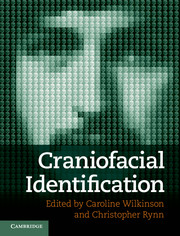Book contents
- Frontmatter
- Contents
- Contributors
- Part I Identification of the Living
- Part II Identification of the Dead
- Chapter 14 Post-mortem prediction of facial appearance
- Chapter 15 Manual forensic facial reconstruction
- Chapter 16 Relationships between the skull and face
- Chapter 17 Automated facial reconstruction
- Chapter 18 Computer-generated facial depiction
- Chapter 19 Craniofacial superimposition
- Chapter 20 Juvenile facial reconstruction
- Index
- Plate Section
- References
Chapter 14 - Post-mortem prediction of facial appearance
Published online by Cambridge University Press: 05 May 2012
- Frontmatter
- Contents
- Contributors
- Part I Identification of the Living
- Part II Identification of the Dead
- Chapter 14 Post-mortem prediction of facial appearance
- Chapter 15 Manual forensic facial reconstruction
- Chapter 16 Relationships between the skull and face
- Chapter 17 Automated facial reconstruction
- Chapter 18 Computer-generated facial depiction
- Chapter 19 Craniofacial superimposition
- Chapter 20 Juvenile facial reconstruction
- Index
- Plate Section
- References
Summary
Introduction
Forensic facial depiction is the interpretation of human remains in order to attempt to depict the living appearance of an individual (Gerasimov, 1971; Prag and Neave, 1997; Taylor, 2001; Wilkinson, 2004). It can be a powerful tool that significantly enhances the chances of identification of the deceased. Following major natural disasters, such as the tsunami of 26 December 2004 and Hurricane Katrina of August 2005, human remains may be extremely difficult to recognise due to decomposition or environmental effects; clothing and personal items may be lost and dental records unavailable (Thompson and Black, 2006). Even where facial preservation is sufficient for recognition by a family member to be attempted, the emotional circumstances result in many examples of false recognition (Hill, 2006). Ten per cent of victims of the tsunami and 50% of victims of the Bali bombing of 12 October 2002 were wrongly identified by facial recognition (Lain et al., 2003). The social, legal and religious implications of misidentification are enormous. International investigative authorities advocate that it is vital to identify the deceased to allow remains to be returned to their families for proper recognition and religious observance, for grieving and acceptance of death and for judicial matters of estate (Lain et al., 2003). With mass disasters such as these, the usual accepted methods of identification are often inappropriate and the importance of unusual and less definitive methods of identification has been recognised. The techniques of craniofacial reconstruction or post-mortem depiction can help resolve many stalemates within identification investigations (Wilkinson et al., 2006).
The ultimate aim of post-mortem prediction is to recreate an in vivo countenance of an individual that sufficiently resembles the decedent to allow recognition (Prag and Neave, 1997). In forensic situations when combined with a publicity campaign, facial depiction may lead to recognition by a member of the public, and hence lead to the identification of that individual. It is currently very difficult to predict facial appearance from partially decomposed remains with any reliability, especially where analysis of the skull is not possible (where invasive assessment or radiographic analysis is inappropriate).
- Type
- Chapter
- Information
- Craniofacial Identification , pp. 166 - 183Publisher: Cambridge University PressPrint publication year: 2012
References
- 2
- Cited by



